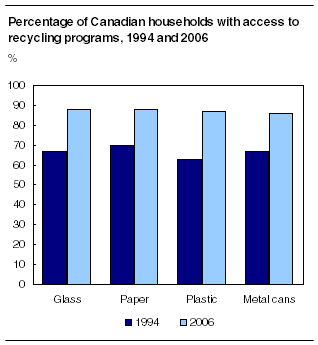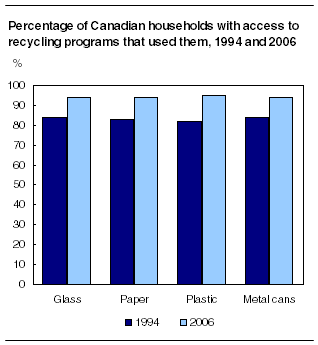Common menu bar links
Envirostats: Recycling in Canada
Archived Content
Information identified as archived is provided for reference, research or recordkeeping purposes. It is not subject to the Government of Canada Web Standards and has not been altered or updated since it was archived. Please "contact us" to request a format other than those available.

Access to recycling programs, and their use, have improved substantially in Canada since the mid-1990s, and Canadian households are recycling more waste than ever before, according to a report in the new online publication EnviroStats.
The vast majority of Canadian households that had access to recycling programs made use of them in 2006, regardless of household income, the occupants' education levels, or the type of dwelling, the report showed.

The use of recycling programs was high across all provinces, whether households were in apartments or single-detached homes.
Among households that had access to recycling programs, about 97% of those in single-detached homes recycled waste, as did 95% of those in low-rise apartments. Education levels of the occupants had only a slight impact on recycling behaviour.
Note to readersThis release is based on the feature article titled "Recycling in Canada" in EnviroStats (16-002-XIE), Statistics Canada's new quarterly bulletin of environmental and sustainable development statistics. The article used data from three surveys: the 2004, 2002, and 2000 Waste Management Industry Survey; the 2006 Households and the Environment Survey, conducted as part of the Canadian Environmental Sustainability Indicators project, and the 1994 Households and the Environment Survey. The Waste Management Industry Survey publishes data on the tonnage of waste disposed and diverted, by source. Residential recyclable materials include solid non-hazardous materials produced in residences, such as materials that are picked up by the municipality (either using its own staff or through contracting firms) and materials from residential sources that are self-hauled to depots, transfer stations and disposal facilities. Data do not cover any wastes that are managed on-site by the waste generator. For the Households and the Environment Survey, access to a recycling program indicates that households reported that they had access to a municipally- or privately-operated collection system, including curb-side pick-up or drop-off centres or depots. |
The report was published today in the inaugural edition of EnviroStats, Statistics Canada's new quarterly bulletin on environmental and sustainable development statistics.
In 2004, households produced 13.4 million tonnes of waste, according to the Waste Management Industry Survey. Of this amount, nearly 3.6 million tonnes went to recycling, a 65% increase from 2000.
During this four-year period, the proportion of household waste that was diverted to recycling increased from 19% to 27%.
In 2004, the average Canadian recycled 112 kilograms of material, compared with 71 kilograms in 2000. Recycling rates in 2004 ranged from a high of 157 kilograms per capita in Nova Scotia to a low of 54 kilograms in Saskatchewan.

The provinces: Not all offer equal access to recycling programs
Although access to recycling programs has improved over the years, not all provinces were offering equal access to recycling programs in 2006.
Data from the Households and the Environment Survey (HES) show that in 2006, 93% of Canadian households had access to recycling programs for at least one recyclable material: glass, paper, plastics and metal.
Prince Edward Island led the pack in terms of both access and use. Nearly all the province's households (99%) reported having access to, and making use of, at least one recycling program. Nova Scotia and Ontario rounded out the top three for both access to and use of recycling programs for glass, paper, plastics and metal.
Manitoba was below the median for use of all recycling programs. While 90% of households in the province had access to recycling programs, only 88% of these households did recycling, making Manitobans least likely to recycle.
In general, provinces offered fairly comprehensive access to recycling programs for different materials. About 88% of households had access to glass and paper recycling programs, 87% had access to plastic recycling, and 86% had access to recycling for metal cans.
The notable exception was Newfoundland and Labrador, where only 35% of households reported having access to paper recycling, while 61% had access to metal recycling, 72% to plastic and 75% to glass.
Use of paper recycling in Newfoundland and Labrador was only 74%, but it was 90% and above for the other three materials.
Overall, access in Canada to glass, paper, plastic and metal recycling programs improved between 1994 and 2006. This was also true in each province, except for New Brunswick, where access to glass and metal recycling declined slightly.
Of all the provinces, Prince Edward Island showed the biggest improvement in access between 1994 and 2006. Fewer than 21% of households had access to programs for each recyclable material in 1994. By 2006, this had increased to over 95%.
Factors affecting access to programs
While access to recycling programs varied by province and municipality, results of the 2006 HES show that access also differed according to social and economic characteristics.
Access to recycling was highest for those living in single detached homes, with 96% having access to a recycling program. Households living in mobile homes and apartment buildings were less likely to have access to recycling programs. About 90% of households in mobile homes had access, compared with 85% in low-rise apartments.
Differences in access are also apparent based on income and education, important indicators that can influence whether households own or rent, and whether they live in detached homes or apartments.
On average, 98% of households with an income greater than $80,000 had access to recycling compared with 89% of households with an income of less than $40,000.
As well, 95% of households with at least one university graduate had access to recycling programs. On the other hand, only 87% of households where no one had completed high school had access.
Definitions, data sources and methods: survey number 3881.
The complete results from the 2006 Households and Environment Survey, as part of the publications Households and the Environment (11-526-XIE, free), were released in The Daily on July 11, 2007.
The inaugural edition of EnviroStats (16-002-XIE, free) is now available from the Publications module of our website. This online publication will provide regular statistical analysis of environmental topics written for a broad audience. At the core of each issue is a feature article. Shorter articles will highlight new statistical developments or introduce new concepts. This inaugural edition includes an article examining the impact of Canada's population growth on the environment during the last half century.
A section entitled "Updates" will cover recent and upcoming events, such as releases of new statistical products or overviews of surveys currently underway. A data table will provide the most recent statistical indicators of environment and sustainability, and each issue will feature a map illustrating and analyzing a current topic.
For more information, or to enquire about the concepts, methods or data quality of this release, contact the Information Officer (613-951-0297; environ@statcan.gc.ca), Environment Accounts and Statistics Division.


 Table(s).
Table(s).